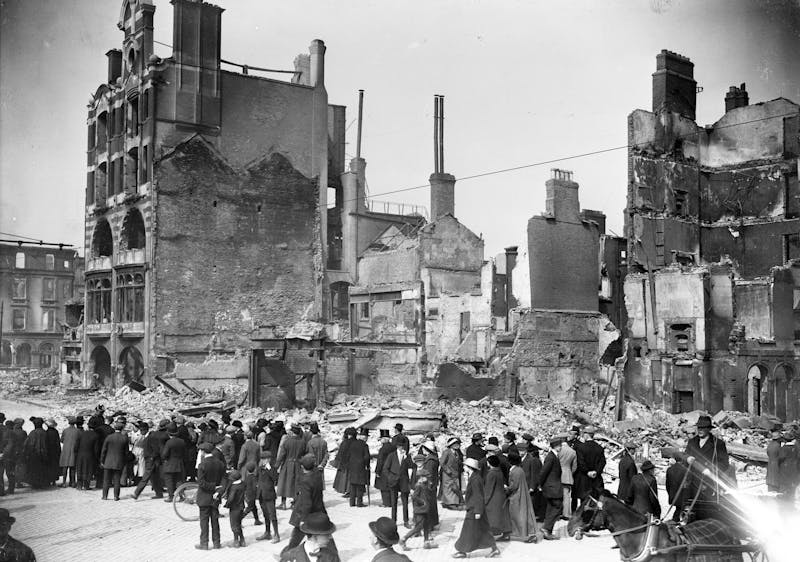On April 24, 1916, members of the Irish Volunteers and other like-minded groups occupied the General Post Office in Dublin as a part of an ultimately futile effort to spark a rebellion against British rule. The rebellion—or Easter Rising—got off to a stuttering start, stalled, and was then quickly and vigorously crushed. By mid-May, most of its leaders—a mix of poets and dreamers, pragmatists and revolutionaries—had been executed.

Marking the 100-year anniversary of the Rising, we should note something important: Across the Atlantic, African Americans watched the unfolding drama with great interest. To some, moreover, it seemed like a fascinating, provocative parallel. “The white slums of Dublin represent more bitter depths of human degradation,” wrote W.E.B. Du Bois, editor of the National Association for the Advancement of Colored People’s monthly magazine, The Crisis, “than the black slums of Charleston and New Orleans, and where human oppression exists there the sympathy of all black hearts must go.” Expressing solidarity across the color-line for victims of a colonial domination that echoed much of what he’d seen in the United States, Du Bois took it one step further. “The recent Irish revolt may have been foolish,” he closed, “but would to God some of us had sense enough to be fools.”
No single figure associated with the Rising attracted attention quite like Roger Casement, the globetrotting anti-imperialist renowned for his earlier efforts to expose the worst abuses of the indigenous in Africa and South America. Casement, though, had been imprisoned during the months leading up to the rebellion, and wasn’t closely connected to its planning. His failed attempt to orchestrate the landing of German weapons on the shores of Ireland—a capstone to his radical revolutionary efforts—had been a sort of political prologue to the rebellion in Dublin, but it had also removed him from the playing field. Captured onshore in County Kerry on April 21, he’d been shuttled off to the Tower of London. While he was confined there, his life as a queer cosmopolitan would be strategically exposed by the British, and used as background justification for his death at the end of the hangman’s noose in August and his all-too punitive traitor’s burial in a pauper’s grave.
Nevertheless, in Harlem, it was the dapper, gentlemanly, gay Casement who symbolized the potential of the Easter Rising. Du Bois, writing on the eve of Casement’s impending execution in The Crisis, acknowledged his treachery, but still admired the man, calling him “an Irish patriot whose memory will be cherished at every fireside as one who dies for his country.” Du Bois’s editorial on Casement was deemed, by some, too tepid; in a sign of a deeper cross-Atlantic connection, one Irish reader wrote to The Messenger, another black monthly, to condemn the Crisis editor for “parrot[ing] the English cry of ‘traitor’.”
Indeed, for the next decade, Roger Casement—and, through him, the Rising—would be a meaningful symbol of anti-colonial radicalism across the spectrum of black politics in Harlem. Marcus Garvey, the extraordinary Jamaican émigré and visionary organizer, would invoke him as an analogue, suggesting that, like the gentlemanly sojourner who’d “led the fight for Irish freedom,” he would be willing to die for Africa. Adding a green stripe to his Universal Negro Improvement Association uniform as a signifier of solidarity with Ireland, Garvey proudly suggested, a few years later, that he was in direct communication with Irish rebels, and argued that the Irish struggle was one and the same with the fight for equality waged by the “400,000,000 Negroes of the World.”
This focus on the Easter Rising did not come out of nowhere. Antislavery activist Frederick Douglass, touring Ireland, discovered a land that welcomed his thoughts on resistance to the master class’s authority, and felt at home there, recalling it fondly for the rest of his life, and wondering why the poor, downtrodden Irish were so much more sympathetic than their American offspring. Even as Garvey and Du Bois expressed their bleak admiration of the Rising and Casement, Alain Locke and Claude McKay—and later, more than a few Harlem Renaissance writers—pointed to the Ireland of Yeats and Hyde and Synge as an example they ought to follow, and their efforts to recover a folk essence in prose and poetry were rooted in a sense of nationalist parallelism.
“I suffer with the Irish,” wrote the poet and novelist Claude McKay in 1921, “I think I understand the Irish. My belonging to a subject race entitles me to some understanding of them. And then I was born a peasant; and the peasant’s passion for the soil possesses me, and it is one of the strongest passions in the Irish revolution.” Setting aside their “political significance,” Locke wrote in 1925, “Harlem has the same role to play for the New Negro as Dublin has had for the New Ireland.”
At every step, this connection depended on the acknowledgement of a great fracture—on the ability, that is, of African American and Afro-Caribbean activists to recognize that the Irish in America had already succumbed to whiteness, and that they’d been absorbed politically and socially into a white supremacist United States. They recognized this and then, astonishingly, set it aside. The Irish in Ireland may well have been white, and their offspring in the New World might well be racist, but they were nevertheless engaged in the same struggle for human dignity, and their struggle might have meaningful consequences for the fight against Jim Crow at home and empire in Africa.
